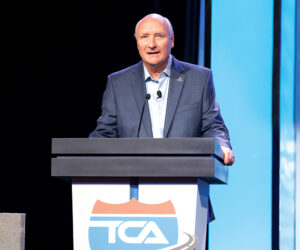Regulations take the spotlight in this edition of Capitol Recap. The Entry Level Driver Training rule has been delayed; the FMCSA has decided that that the percentage of drivers undergoing random drug testing should be set at 50%, twice the current rate; and the Insurance Institute for Highway Safety expresses concern over portions of the proposed hours-of-service regulations.
The following articles appear as they were published in the March-April issue of Truckload Authority.
ELDT rule delayed
The Federal Motor Carrier Safety Administration (FMCSA) has released an interim final rule that calls for a two-year delay in implementation of the Agency’s Dec. 8, 2016, final rule “Minimum Training Requirements for Entry-Level Commercial Motor Vehicle Operators,” more commonly known as the ELDT final rule. FMCSA asked for comments on the delay.
The interim final rule extends the compliance date for the rule from Feb. 7, 2020, to Feb. 7, 2022.
The notice, announced by FMCSA on Jan. 29 and posted in the Federal Register on Feb. 4, said the delay in the compliance date would provide FMCSA additional time to complete development of the Training Provider Registry (TPR). The TPR will allow training providers to self-certify that they meet the training requirements and will provide an electronic interface that will receive and store ELDT certification information from training providers and transmit that information to the state driver-licensing agencies (SDLAs).
FMCSA said the extension also provides SDLAs with time to modify their information-technology systems and procedures, as necessary, to accommodate their receipt of driver-specific ELDT data from the TPR.
FMCSA said it was delaying the entire ELDT final rule, as opposed to a partial delay as initially proposed, because of delays in implementation of the TPR that were not foreseen when the proposed rule was published.
The Federal Register notice was not a surprise to the trucking industry because in late November, FMCSA announced it was preparing the notice but did not know when it would be published.
“Following a careful review of the public comments regarding the Entry-Level Training (ELDT) rule, FMCSA is extending the rule’s implementation for two years,” said an FMCSA spokesperson in November. “This extension is reflective of the Agency’s continued efforts to develop a secure and effective electronic trainer-provider registry for the new rule. The Agency remains committed to making the implementation of the rule as efficient and effective as possible.”
Truckload Carriers Association Vice President of Government Affairs David Heller expressed concerns. “As an original member of the Entry-Level Driver Training Advisory Committee (ELDTAC), I am particularly concerned over the additional two-year window needed to promulgate a rule that was finalized almost three years ago in an effort to create a safer, better-trained driver,” he said.
IIHS Concerns About HOS
The Insurance Institute for Highway Safety (IIHS) has expressed concerns about portions of the proposed changes to the hours-of-service (HOS) rule that the organization believes would extend the daily work period under certain circumstances.
IIHS, an independent, nonprofit scientific and educational organization dedicated to reducing deaths, injuries, and property damage from motor-vehicle crashes, said federal regulators’ plans to relax rules governing the hours professional truck drivers can spend behind the wheel raises concerns about safety. IIHS acknowledged none of the proposed changes would extend the 11-hour driving window.
“Driver fatigue is a major risk factor in large-truck crashes,” said IIHS Senior Statistician Eric Teoh.
Truckload Carriers Association Vice President of Government Affairs David Heller said flexibility in the hours-of-service rule is important to the trucking industry.
“Right now, drivers only average six or seven hours of drive time each day,” he said. “So, at this point in time, whether they view the day being longer or continuous is pointless because we as an industry aren’t even averaging anywhere near those numbers anyway.”
IIHS noted that in a study of large trucks involved in crashes with injuries or deaths, researchers from the organization and the University of North Carolina Highway Safety Research Center found drivers using a short-haul exemption had a crash risk nearly five times higher than those who did not.
Specifically, professional truck drivers who reported driving beyond 12 hours since an extended sleep period were 86% more likely to crash than drivers who had been awake for less than eight hours. Drivers who reported driving more than five hours without stopping were more than twice as likely to crash as those who drove one to five hours.
Another change FMCSA is proposing would allow drivers to expand the standard 14-hour window in which driving must be completed to 16 hours if they encounter adverse conditions, such as bad weather or unexpected traffic. Currently, drivers may extend their driving time under adverse conditions, but the window remains 14 hours. FMCSA said extending the driving window would encourage drivers to wait out the adverse conditions or drive slowly through them, rather than attempting to drive quickly to move beyond poor driving conditions. However, it theoretically creates a longer work period and could therefore increase fatigue, IIHS said.
Another proposed change noted by IIHS is an option to stop the clock on the 14-hour driving window for an off-duty break of between 30 minutes and three hours.
“FMCSA says that a three-hour rest in the middle of a shift would offset any potential downside of a 17-hour day, but that’s far from certain,” argued Teoh.
Drug-testing increases
The Federal Motor Carrier Safety Administration (FMCSA) has announced it will increase the annual percentage rate for random controlled-substances testing for CDL holders to 50%. The percentage increase takes effect for the calendar year 2020 and is double last year’s 25%.
Under federal law, the testing percentage must increase “when the data received under the reporting requirements for any calendar year indicates that the reported positive rate is equal to or greater than 1.0%,” according to the FMCSA’s Dec. 26 notice. The requirement stems from the “Controlled Substances and Alcohol Use and Testing” rule issued in 2001, which indicates that the decision on whether to increase or decrease the percentage rate would be based upon the motor-carrier industry’s overall positive random controlled-substance test rate, as reported by motor carrier employers to FMCSA.
The FMCSA notice states that the estimated positive random controlled-substance test rate in 2018 was 1%. For 2016 and 2017, the estimated positive usage rate for drugs was estimated to be 0.7% and 0.8%, respectively.
The notice further states that, based on the 2018 survey results, the estimated percentage of subject motor carriers with random controlled-substance and alcohol testing programs in place is 94%, and the estimated percentage of all CDL drivers participating in such programs is 99%.
“This is a good thing,” shared Truckload Carrier Association Vice President of Government Affairs David Heller. “We had the 50% threshold a few years ago. It’s no secret this nation has an opioid epidemic and, quite honestly, marijuana seems to be legalized at the state level every day. However, it is still illegal in terms of federal regulations. The 50% random test-rate number where we were two years ago allows our industry the opportunity to continue with a zero-tolerance policy. We won’t stand for drugs or alcohol to be used behind the wheel of the truck.”
Heller posed the question, “So, how does this relate to the Drug and Alcohol Clearinghouse? It certainly increases the opportunity for carriers to discover illegal activity that is going on within their driving population,” he said. “Growing from 25% to 50% for random testing allows for greater opportunities to test the majority of your fleet.”
FMCSA estimates there are 3.2 million CDL holders operating in interstate commerce and 1 million CDL holders operating in intrastate commerce. Based on these numbers, at least 1.05 million random controlled-substances tests would be conducted with an annual random-testing rate of 25% of all driving positions. At a 50% annual random-testing rate, approximately 2.1 million random controlled-substances tests will need to be conducted.
Requiring that more drivers be tested will set the industry back an additional $50 to 70 million dollars. The minimum annual percentage rate for random alcohol testing will remain at 10%.
AB5 restraining order
The federal judge who issued a last-moment restraining order preventing the State of California from enforcing its new AB5 law on motor carriers has granted another reprieve following a Jan. 13 hearing. Many industry stakeholders anticipated the judge would approve the California Trucking Association’s (CTA) request for a preliminary injunction in the case. Yet, at the close of the hearing, U.S. District Judge Roger Benitez extended the restraining order until he rules on the injunction request. On Jan. 16, he granted a temporary injunction indefinitely prohibiting enforcement of AB5 against motor carriers.
A new development in California AB5 came early February when a bill that mirrors the California law was introduced in the Democratic-controlled U.S. House of Representatives.
If the bill makes it to the Senate, Republicans say it will be defeated, Benitez’s initial decision followed lengthy arguments in which he questioned both CTA representatives and those from the State of California. The AB5 law is now in effect for most California employers other than motor carriers, although freelance writers and photographers, Uber drivers, and some construction-related businesses have filed separate lawsuits.
AB5 requires employers to use an “ABC” test to determine if a worker is an independent contractor or employee of the company. Most problematic for the trucking industry is the “B” prong, which states a company cannot use independent contractors to perform work unless it is “outside the usual course of the hiring entity’s business.” In other words, according to the CTA and other industry stakeholders, AB5 prevents a motor carrier from working with independent contractors (i.e., owner-operators), an arrangement used by most motor carriers for decades.
“This decision was important to the industry because the industry supports a business model that has been in place for decades,” said Truckload Carriers Association Vice President of Government Affairs David Heller. “TCA has a large number of carriers that use the independent contractor model. Our members actively work to uphold and surpass all associated rules and regulations to ensure owner-operators are treated fairly. We applaud the ruling that has come out of the courts, and hope AB5 never goes into place in California or any other state.”
AB5 is intended to prevent companies from classifying “would-be” employees as independent contractors, relationships that save companies money as they do not have to offer benefits or paid time off, or pay a portion of the contractor’s payroll taxes. On the other hand, many independent contractors prefer such an arrangement for the flexibility it offers in accepting work, charging competitive fees, and allowing them to contract with multiple companies.
Under AB5, thousands of California-based owner-operators (estimated to comprise over 25% of truck drivers in the state) would essentially be left unemployed, at least in California. Reports indicate at least one nationwide carrier, Prime Inc., has offered 6,000 independent contractors “relocation packages” to assist them in moving out of California, where the contractors would be exempt from the law. Such relocations will likely impact stakeholders throughout the trucking industry as truck sales, repair orders, diesel sales, and even advertising will likely decrease at a rate corresponding with the number of independent contractors who choose to move to another state.
For the time being, carriers and independent contractors alike can sit tight. With a preliminary injunction in place, both are protected from AB5 for now, and the wheels of justice turn slowly.
Help stop trafficking
In January, U.S. Department of Transportation Secretary Elaine Chao announced a series of efforts that aim to combat human trafficking in the transportation sector. Congressional leaders, state government personnel, and transportation-industry stakeholders, joined Secretary Chao in her call to action.
“The U.S. Department of Transportation is committed to working with our public and private partners to fight human trafficking on America’s transportation system,” said Chao.
Among the initiatives announced by Chao is a renewed focus on the “Transportation Leaders Against Human Trafficking” pledge to train the transportation workforce and raise public awareness on the issue of human trafficking across all modes of transportation. Secretary Chao is challenging the transportation industry to commit to “100 Pledges in 100 Days.” The Department anticipates more than 1 million employees across all modes of transportation will take part in this initiative.
“Secretary Chao’s announcement certainly continues to place this problem at the front and center as one of the biggest issues that plagues our nation,” said Truckload Carriers Association Vice President of Government Affairs David Heller. “What’s worse is that a majority of the victims are put in these scenarios against their will. They’re not choosing to be in this situation. What makes trucking so prominent in this initiative is the proverbial size of our industry and the eyes and ears that we possess in order to report problems and help people in need. We as an industry have always taken a stance against this heinous crime and we will continue to do so. And this human trafficking event just emphasizes that.”
Human trafficking is modern-day slavery, affecting millions of adults and children in the United States and worldwide. Victims are of every age, race, gender, background, citizenship, and immigration status. Some are trafficked within their own communities on various forms of transportation, while others are transported to new locations.
Truckers Against Trafficking (TAT), through its educational programs, plays a key role in the trucking industry’s efforts to curb trafficking.
TAT statistics show that to date 845,115 professional truck drivers are registered as TAT trained, 2,496 have made calls for the National Human Trafficking hotline, 663 likely indicators have been generated, and 1,230 victims have been identified.
If you see or suspect a case of human trafficking during your travels, call 911 or the National Human Trafficking hotline at (888) 373-7888. If you cannot call, text 233733.
Lyndon Finney’s publishing career spans over 55 years beginning with a reporter position with the Southwest Times Record in Fort Smith, Arkansas, in 1965. Since then he’s been a newspaper editor at the Southwest Times Record, served five years as assistant managing editor of the Arkansas Democrat-Gazette in Little Rock and from November 2004 through December 2019 served as editor of The Trucker. Between newspaper jobs he spent 14 years as director of communications at Baptist Health, Arkansas’ largest healthcare system. In addition to his publishing career he served for 46 years as organist at Little Rock’s largest Baptist church.








